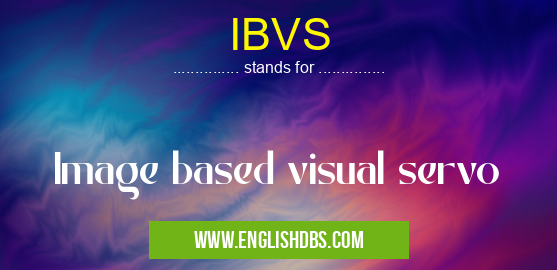What does IBVS mean in UNCLASSIFIED
IBVS stands for Image Based Visual Servo, which is a type of servomechanism that controls the motion of an object by processing images from cameras and other vision sensors. By using image-based visual servoing, robots or other autonomous systems can perform complex tasks without relying on external feedback. IBVS uses computer vision algorithms to detect objects in the environment as well as to track their movements. In addition to controlling the motion of an object, image-based visual servoing can also be used to plan intelligent paths for diversified tasks.

IBVS meaning in Unclassified in Miscellaneous
IBVS mostly used in an acronym Unclassified in Category Miscellaneous that means Image based visual servo
Shorthand: IBVS,
Full Form: Image based visual servo
For more information of "Image based visual servo", see the section below.
Benefits of Using IBVS
One of the main advantages of using image based visual servoing compared to other methods of robotic control is increased accuracy due to better chances at catching errors early on in the process before they become too costly or difficult to fix later down the line. Additionally, since no external feedback is required during operation, this approach allows robots or autonomous systems greater operational autonomy when carrying out complex tasks in dynamic environments.
Essential Questions and Answers on Image based visual servo in "MISCELLANEOUS»UNFILED"
What is Image Based Visual Servo (IBVS)?
Image Based Visual Servo (IBVS) is a feedback-based robotic control system which uses camera images to drive and position the robot. It uses a vision guidance system to compare an image of the current environment to a desired target, and adjusts its control commands to move closer to that target.
How does IBVS work?
IBVS works by taking an image of the environment, extracting features from this image, comparing them to a desired configuration, and adjusting its servo parameters in order to move closer to the desired configuration. This process of image acquisition and feature comparison is repeated until the robot is in the desired position.
What are the benefits of using IBVS?
Using IBVS makes it possible for robots to interact with their environment in a more intuitive way than traditional motion control systems. It also provides robots with greater precision in positioning and tracking targets over larger areas than can be achieved with other methods. Furthermore, it simplifies programming significantly by removing the need for complex path planning algorithms.
What types of robots can use IBVS?
Any type of robot can potentially benefit from using IBVS as long as it has sensors capable of capturing images of its environment. This makes IBVS particularly suitable for mobile robots or service robots which must regularly interact with their environments.
Are there any drawbacks associated with using IBVS?
The primary drawback associated with using IBVS is that it requires a powerful processor in order to efficiently extract features from images and compare them against target configurations. Additionally, some applications may require additional cameras or sensors for more accurate positioning and tracking capabilities.
Is programming necessary when implementing IBSV?
Yes, programming is necessary when implementing IBSV as you must define what constitutes an acceptable position or trajectory for your robot’s motors or actuators. You will also need to define how you want your robot’s sensors to respond in different scenarios before you can put your vision guidance system into action.
Are there any open source libraries available for developing IBSV systems?
Yes, there are several open source libraries available which users can utilize when developing Robotics applications utilizing IBSV technology such as OpenCV, PCL (Point Cloud Library), ROS (Robot Operating System), MoveIt! and Stage Simulator 2D/3D libraries.
Final Words:
In conclusion, image based visual servo (IBVS) offers a reliable yet cost effective way for robots or autonomous systems needing precise motion control capabilities in uncertain environments without relying on additional feedback sources. It leverages state-of-the art computer vision techniques such as object detection and tracking algorithms combined with sophisticated planning strategies so that robots can safely navigate towards their desired destinations while avoiding any potential hazards along the way.
